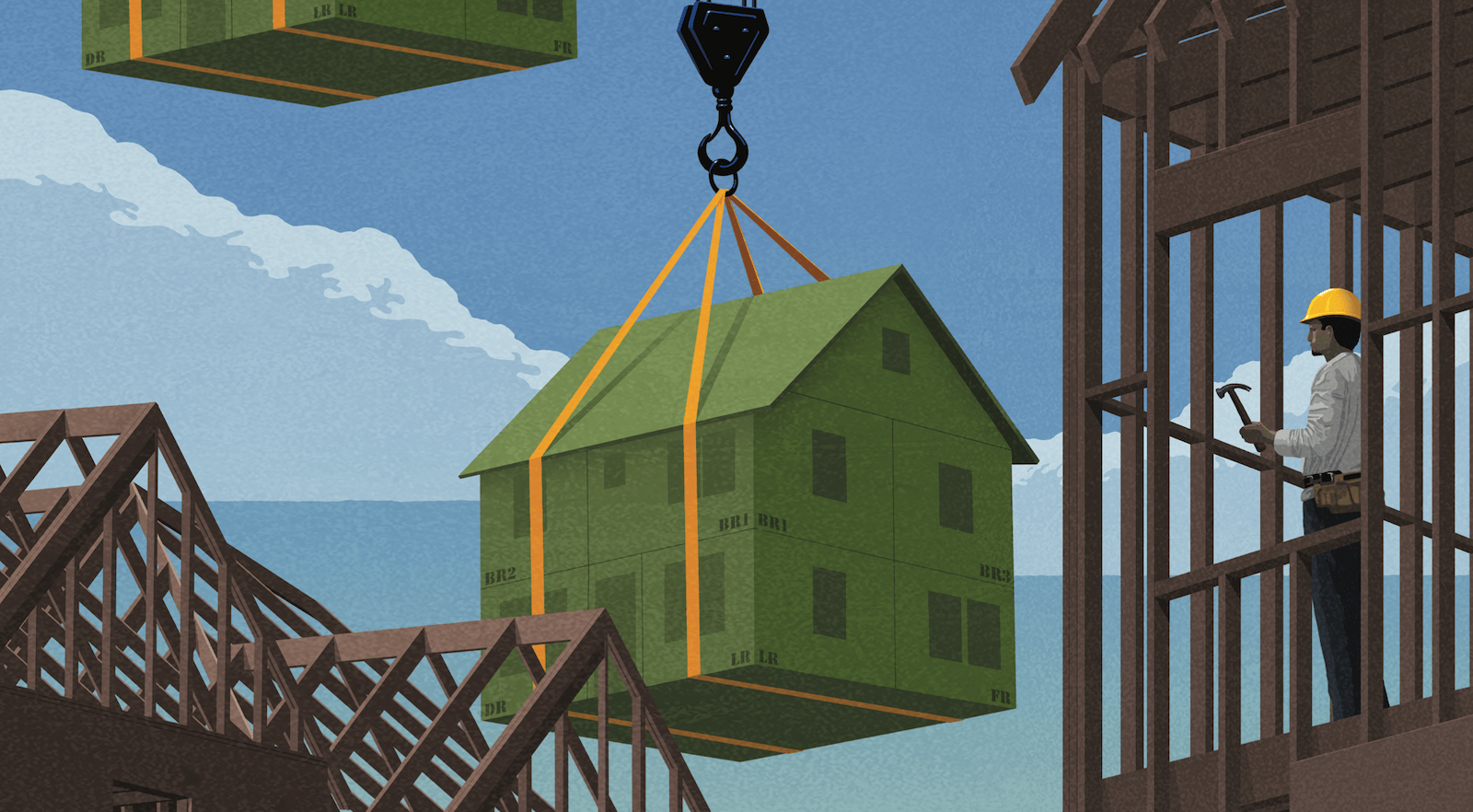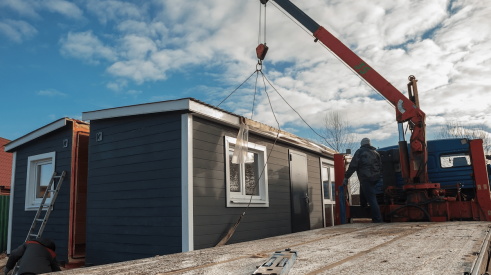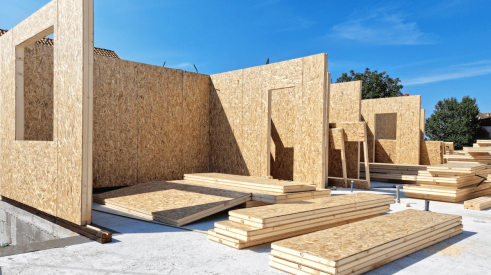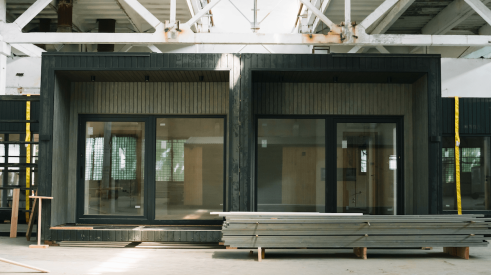From July 2019 through July 2020, Rise, a website for consumers and professionals that provides information about sustainable building practices and sells sustainable products, tapped into internet and social media conversations among consumers about off-site home construction.
The bulk of that chatter focused on the sustainability and affordability aspects that off-site methods promise, but also on improved durability and reduced build time. And “prefab” emerged as the preferred term for that building method among consumers.
The data Rise collected backs up what many in the residential construction industry are slowly realizing: Homebuyers have a sincere interest in, a baseline knowledge of, and a curiosity about—and far less bias against—homes built mostly or entirely in a factory.
Responding to such insights and understanding how to properly market and communicate prefab to consumers is necessary if industrialized construction (IC), including all forms of panelized and modular methods (excluding HUD-code units), expects to grow beyond its current 3% share of new single-family homes completed in 2020, the latest data available from the U.S. Census Bureau.
Despite increasingly heavy pressure to do something different, that market share has been stagnant for years after peaking at about 7% in 1998. But there are encouraging signs that IC is on the way up. In a survey by Pro Builder of more than 1,100 builders last year, 22.1% indicated they would use “modular or off-site construction” in their near-term future, up from just 8% only a year earlier.
RELATED: MORE 2022 HOUSING GIANTS ARTICLES AND DATA
- Housing Giants 2022: What Now? The Housing Industry Post-Pandemic
- Built-to-Rent: What Happens When the Dust Settles?
- 2022 Housing Giants List: U.S. Home Builder Rankings by 2021 Revenue and Closings
- 2022 Housing Giants rankings by housing type and region
In a separate survey a few months prior, in partnership with the research, testing, and consulting firm Home Innovation Research Labs, 13% of builders reported they anticipate using modular housing in the next five years, while 19% found off-site, in general, “more favorable” after the pandemic than before.
“We’re seeing more engineers, architects, developers, and government agencies starting to embrace this,” says Tom Hardiman, executive director of the Modular Home Builders Association (MHBA). But getting the message out to consumers and homebuyers is going to take a concerted effort.
“Growing the [IC] industry is a push-pull,” says Dave Cooper, a home builder, online talk show host, and off-site construction evangelist. “There needs to be some unified messaging for consumers around industrialized construction on one side, and on the other, getting more home builders, designers, and architects to request it as well.”
Steve Linton, president of Deltec Homes, in Asheville, N.C., which sells its prefabricated product directly to homebuyers, believes consumers are the key to the segment’s growth—providing the push in a pull-hesitant environment. “The more they ask for it, the more builders and Realtors will pay attention,” he says. “They’ll drive it.”
Eventually, Cooper also believes consumers will ask for (or at least about) prefab construction in the same way they now ask a doctor for a particular medicine or brand, the result of aggressive advertising by pharmaceutical companies. But creating a similar momentum around IC likely requires a cohesive, well-financed, and equally aggressive effort among the segment’s stakeholders.
Industrialized Construction Road Map: In 2020, with the help of a working group consisting of home builders, suppliers, researchers, and other industry experts, Pro Builder and Pittsburgh-based Housing Innovation Alliance initiated the development of a comprehensive “Industrialized Construction Road Map” to outline a successful transition of a builder’s overall business model—not just the construction silo—to fully integrate IC into its operations and realize the benefits. This article is one within a series produced to that end, and both Pro Builder and the Alliance maintain stores of research reports, webinar recordings, meeting notes, articles, and other resources for builders.
Industrialized Construction: Stigma? What stigma?
For years, builders have believed consumers stigmatize industrialized construction, visualizing a cheaply built manufactured or mobile home. (In our survey with Home Innovation, 24% of builders cited “Buyers won’t accept it” as a barrier to adopting off-site methods.)
But Ed Hudson, director of market research at Home Innovation, says that attitude is shifting. “Certain homebuyers still have that perception, but it has lessened among younger generations,” he says. “They think building in a factory is really smart.”
Josefin Kannin, marketing director for Seattle-based Lindal Cedar Homes, North America’s largest manufacturer of post-and-beam custom kit homes, agrees. She cites Dwell magazine, popular among those interested in modern architecture, as an industry supporter. “They’ve taken the word ‘prefab’ and used it to talk about something that is very of the moment—something that saves time for homebuyers and saves waste at the build site,” she says. “Those are important talking points.”
What’s also resonating with consumers is cost control. With inflation running high and the supply chain still unpredictable, many stick-builders have been forced to adjust pricing after contract to cover higher costs. But with modular, at least, that’s rarely the case.
“There’s a better understanding of what true modular is among consumers,” adds Ken Semler, founder and president of Impresa Modular, a modular construction custom builder, and past chair of the National Association of Home Builders’ Building Systems Councils. That may be true in the Northeast, where modular alone has a 3% share of new-home builds, but in the Southeast, he says, it gets confused with trailers (read: mobile or manufactured homes), “and we’re fighting that harder.”Linton also sees the stigma about prefab abating, but warns against leading with IC as the primary focus of a homebuyer’s interest. “It’s an important part of the story, but ultimately we have to provide a solution that the customer is after,” whether it’s price, sustainability, design, or a combination of those and other factors. Once you meet those more emotionally driven needs, he says, “you can apply the logic of prefab.”

Off-Site Construction ... Prefab ... Modular ... Volumetric ... Factory-Built ... What’s in a Name?
Building all or parts of a home off site is referred to in a dizzying variety of ways—prefab, modular, panelized, factory-built, off-site, industrialized, volumetric. Worse, each moniker has a slightly different meaning, which is often lost on the homebuying public. “Inconsistent terminology has been a big problem for the industry,” says Tom Hardiman, executive director of the Modular Home Builders Association.
Lindal Cedar Homes, which sells pre-cut post-and-beam custom kit homes via independent distributors, struggles with finding the right words to describe what the company does, says marketing director Josefin Kannin.
Her keyword searches of Lindal’s Google ads reveal that the term “modular” averages about 246,000 searches each month, while “system built” garners just 90. The latter is what Lindal actually does, and its dealers don’t like the term “modular” marketed to their homebuying customers, so Kannin has targeted “prefab” as a compromise. “But that was bringing in low-quality leads,” she laments, namely from people who think the company makes mobile or manufactured homes.
One place to start is the building code. To that end, in November 2021, the Modular Building Institute (of which Hardiman is also executive director) and the International Code Council announced the release of two standards: one for planning, design, fabrication, and assembly (ICC/MBI 1200-2021) and another for inspection and regulatory compliance (ICC/MBI 1205-2021). The hope is that enforced standards—and the use of “off-site construction” for both—will help better sell this production method within home building and to consumers.
Industrialized Construction: Establishing a Food Chain of Education to Challenge Existing Perceptions
Challenging consumer perceptions and jumping on the current zeitgeist surrounding sustainability and affordability means a heavy focus on marketing and education, what Semler calls the “food chain of education.” It’s not just consumers and builders who need to hear the message, he points out, but also lenders, appraisers, real estate agents, and home inspectors.
“Those are the people talking to our customers about what we offer, without understanding the difference between modular and HUD-code homes,” says Brian Gaudio, CEO of Module, a volumetric home provider based in Pittsburgh. “That leads to consumers questioning what it means to have a home built off-site.”
Adds Semler: “There are a lot of tall tales and folklore about the prefab industry. We’ve got to educate en masse.”
Starting in 2010 as an Internet-based company, Impresa has a significant web presence that drives consumers to 2,000 home plans for near-complete volumetric modules produced by 20 facilities nationwide. Impresa sells only to developers, its franchisees (five as of this writing), and to Semler himself, who buys about 300 lots from the company’s developer customers for Impresa to place and sell homes directly to consumers.
The company also offers “immediate pricing,” which Semler knows is one of the main questions homebuyers want answered as soon as possible. To help further educate them about Impresa’s process, the company offers factory tours; Semler also blogs about modular homebuying and construction and speaks to audiences whenever and wherever he can.
“Growing the [IC] industry is a push-pull. There needs to be some unified messaging for consumers around industrialized construction on one side, and on the other, getting more home builders, designers, and architects to request it as well.”
—Dave Cooper, home builder, online talk show host, and off-site construction evangelist
Westchester Modular Homes, based in Wingdale, N.Y., sells only to builders. “But in order to facilitate the sale for builders, it’s prudent for us to educate the retail public,” says John Colucci, VP of sales and marketing. The company uses webinars, open houses, and tours of its 110,000-square-foot factory to educate both audiences.
During the pandemic, Colucci led biweekly virtual factory tours, some lasting nearly two hours and attracting roughly the same number of visitors (about 40) as the live tours offered monthly before COVID, increasing the company’s reach both in audience and geographically—some attendees tuning in from 200 miles away.
Module’s Gaudio is all in on in-person experiences with his company’s product and process. “Any time I can get someone in one of our show homes or our factory, it’s a game-changer,” he says.
What’s also resonating with consumers is cost control. With inflation running high and the supply chain still unpredictable, many stick-builders have been forced to adjust pricing after contract to cover higher costs. But with modular, at least, that’s rarely the case. “Once we sign a contract with a buyer, the price of that house won’t change,” says Joe Enright, VP of Design/Build/Modular, in Bethel, Conn., an authorized Westchester builder.
“Something that saves time for homebuyers and saves waste at the build site ... those are important talking points.”
—Josefin Kannin, marketing director, Lindal Cedar Homes
That benefit isn’t just good for homebuyers looking for price stability. Stick-builders, he says, are flocking to Westchester Modular and others like it for the same reason. “They don’t know what their homes will cost a week after contract,” Enright says. “Whereas we can predict it a few months out.”
Van Metre Homes, which has been offering traditionally built homes in Northern Virginia for the past 65 years, is steadily making its way toward industrialized construction with a vertically integrated approach to that business. “We are not a modular builder yet, but our goal is to become one,” says Christopher Fox, Van Metre Companies’ VP of architecture and building science.
In 2021, Van Metre unveiled POWERhaus (in which “POWER” stands for Progressive, Optimized, Waste-conscious, Efficient, and Renewable) in Chantilly, Va., a townhouse assembled using a system of 11 smaller, near-complete volumetric “cartridges” (plus larger floor and wall modules) built off-site for specific sections, such as the bathrooms. The result is a finished unit “no different from our other homes and built right next to our traditional builds,” Fox says.
Tours of the home revealed a cohort of tech-minded consumers who liked the idea of modular housing and were “amazed it didn’t look like modular,” he says. “Those are the people we’re looking for.”
RELATED
- Your Road Map to Off-Site Construction and Modular Homes
- Forecasting the Future of Home Construction
- Disrupting Home Building: The Rise of IC Outsiders
Shannon Bray, the builder’s director of market research, says the company has a robust marketing and promotional program in place, starting with copy that describes the process as “factory-crafted.”
“Van Metre builds a really good home,” she says, “and by building in a factory, we have figured out a way to build an even better home.” The language fits nicely with the current consumer penchant for “artisanal” everything, she adds.
In addition to the tours, the campaign encompasses an online video series focused on the building process; posts on Facebook and Instagram; e-blasts targeting technology-minded consumers, as well as Van Metre homeowners and prospects; an extensive public relations campaign; a nationwide press release that led to articles in several national trade and consumer publications; and speaking engagements at trade shows and other events. And later this month, Van Metre will break ground on POWERhaus II, a four-unit townhouse project with a refined cartridge system.
The response has been positive from the industry and the public, Bray says, adding that consumers love “the technology, the ‘cool’ factor, the reduced building time, the minimal construction waste, the quality, and our company’s willingness to take building to the next level.”
Converting the Curious Into IC Buyers
But do these efforts actually convert interested parties into buyers? Each Thursday through Sunday, Semler says between 5,500 and 8,500 people visit Impresa’s website, resulting in about 300 registrations for more information per day. “We are trying to create an engine to convert these leads to sales,” he says, but the conversion barrier “is that many people don’t want to have two contracts [one with Impresa and another with a builder].” He also admits that his marketing ability outpaces his production and sales capabilities, but believes it’s a good problem to have.
How consumers experience the home building process with an IC provider may also help convert lookers into buyers. At Deltec, homeowners are assigned to work exclusively with small, cross-functional teams from start to finish; no hand-offs from sales to construction to warranty. “It’s comforting to the customer,” says Linton, and helps Deltec better set and meet buyer expectations.
“Modular companies are more than just materials suppliers. As manufacturers, we have a vested interested in making sure the builder is successful.”
—John Colucci, VP of sales and marketing, Westchester Modular Homes
Colucci says about 10% of the builders who find Westchester Modular come back, but says “it’s difficult to quantify because there are builders we spoke to five years ago who are just now starting to understand modular and are gravitating toward us.”
He says it’s important to keep up the education. “Modular companies are more than just materials suppliers. As manufacturers, we have a vested interested in making sure the builder is successful,” Colucci says. “We rely on their volume. I’m not efficient if I just do one house.”
RELATED
- 3 Ways Machine Learning Can Be Useful in Construction
- On-Site vs. Off-Site: a Total Cost Analysis for Home Builders
Baby Steps Toward Industrialized Construction
A key part of the education equation must also occur downstream, at the trade level. Even if builders and developers (and even consumers) are on board with IC, they may have trouble finding trade partners that can do the on-site work, however minimized compared with traditional frame construction in the field.
Fox says Van Metre is lucky in that Northern Virginia has framers who own equipment for factory-built components—a capability fueled by a robust legacy market for mid-rise condos—to move and place his cartridges. “That’s the first step, in my opinion,” he says. “If framers can’t pick up a roof truss and tilt it, there’s no way they can do stacked modular.” And thus no way (or reason) for builders to sell it to consumers.
That brings us back to the push-pull of consumer demand and builder interest—both requiring patience with the slow wheels of progress. But things are moving forward: While full-scale modular may take longer to find a national niche, prefab wall, floor, and roof trusses and other components are having a greater impact across several markets and housing types.
“We’ve seen a tremendous growth in multifamily housing with panelization, and we’ve seen substantial growth in single-family,” Hudson says. “At this point, close to 10% of all new single-family detached units use some form of panelization.” Others are turning to pre-cut framing packages—especially more recently, Hudson says, as a dearth of skilled carpenters drives up labor costs and supply chain and lumber price spikes bring framing material waste into sharper, bottom-line relief.
Semler believes industrialized construction will be able to address the issues of the skilled labor shortage, housing supply and affordability, and raw material and supply chain challenges—a heady prediction that nonetheless resonates with home builders right now. A smaller labor force will become more impactful, he says, while combining buying power with smart construction and design will limit SKUs, making off-site home construction more cost-efficient.
“In theory, increased use of off-site construction could allow us to more rapidly supply higher inventory to the depleted housing market,” he says. And that’s a message consumers can rally around.
Stacey Freed is a frequent contributor to Pro Builder Media on topics covering residential design, sales and marketing, and business.
Advertisement
Related Stories
Off-Site Construction
Utah Passes Bill to Regulate Modular Construction at the State Level
Goals for housing innovation and affordability meet in the Utah's passage of a new bill that establishes a statewide modular construction program
Off-Site Construction
What's Standing in the Way of Home Builders Adopting Off-Site Methods?
Findings from Home Innovation Research Labs show home builders continue to embrace the status quo when it comes to adopting new methods, but results vary by builder type and region
Off-Site Construction
What's Needed to Ensure Modular Construction Companies Succeed?
Factory-built housing is increasingly being hailed as a solution to the housing shortage and affordability crisis, but the companies building those homes are failing







